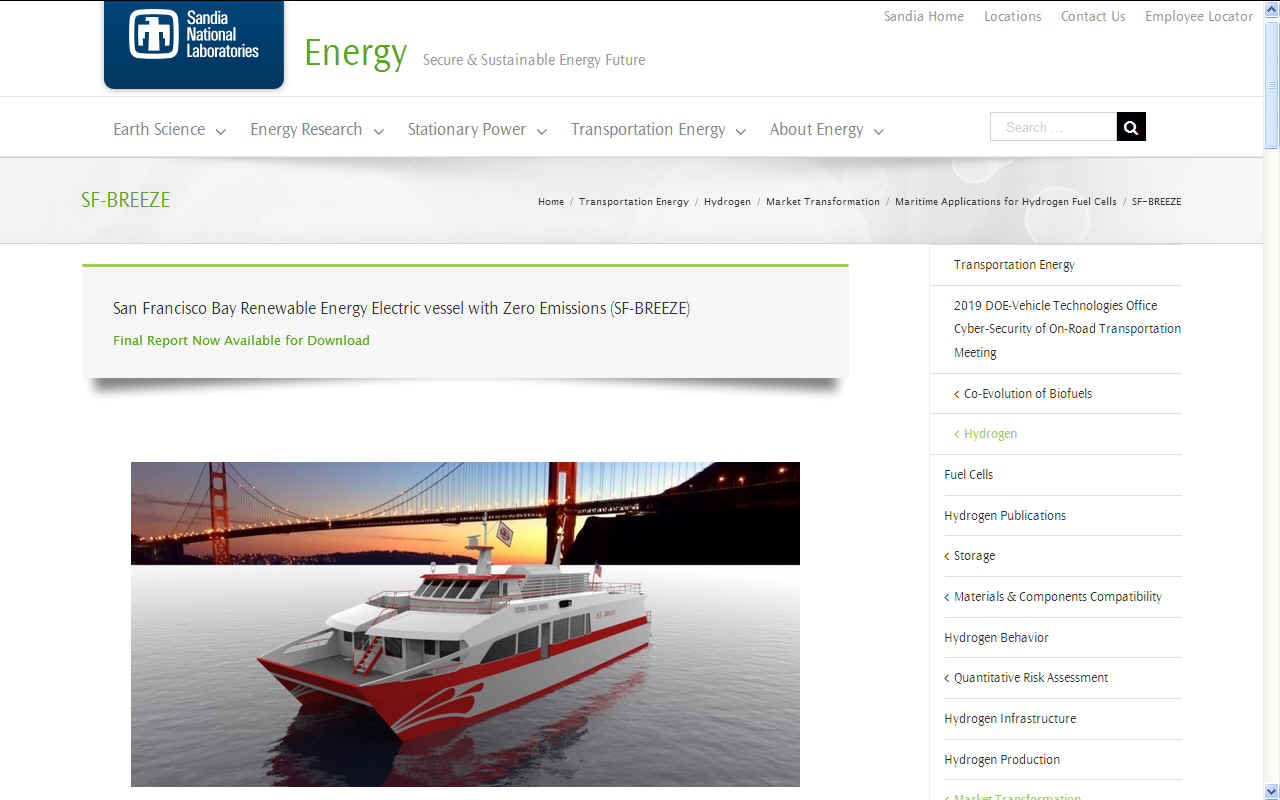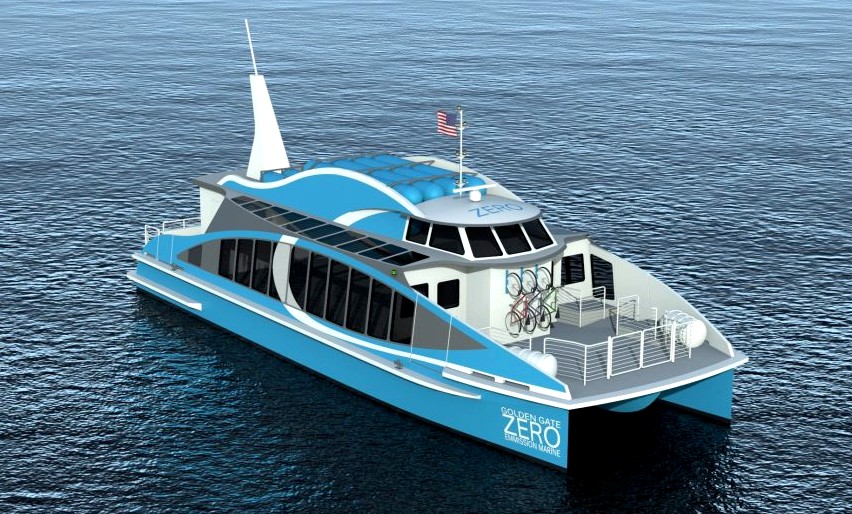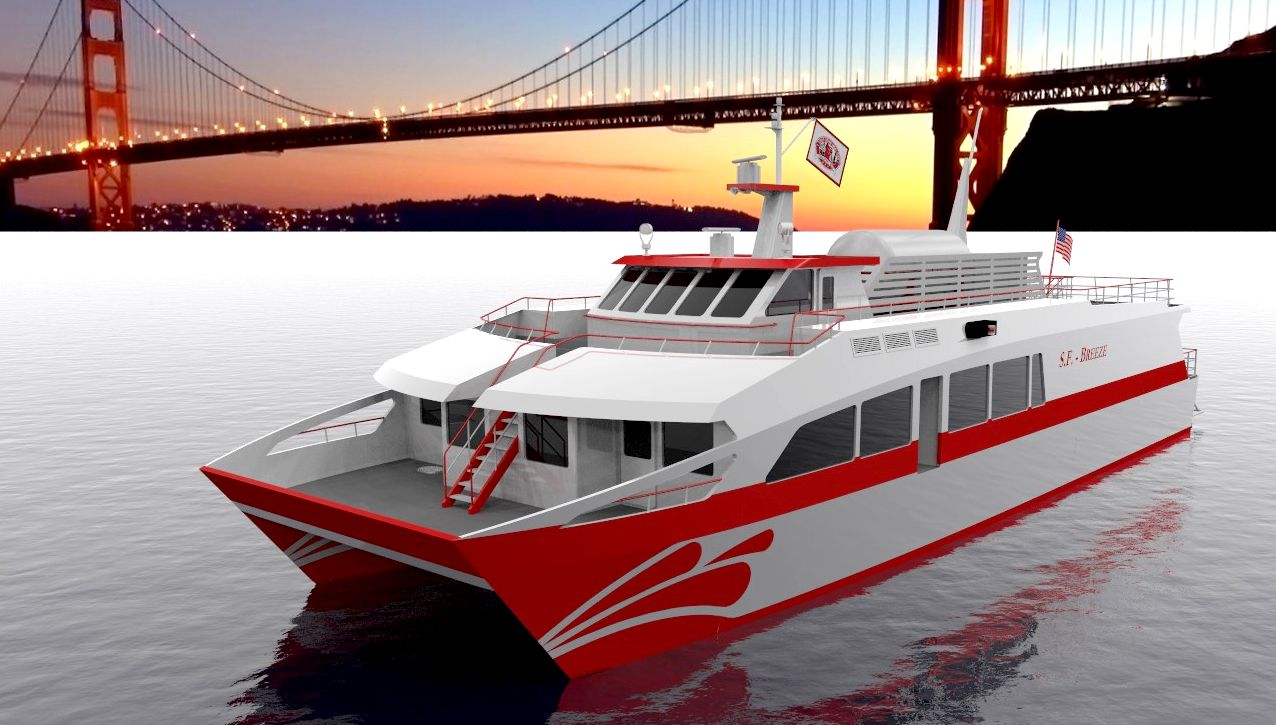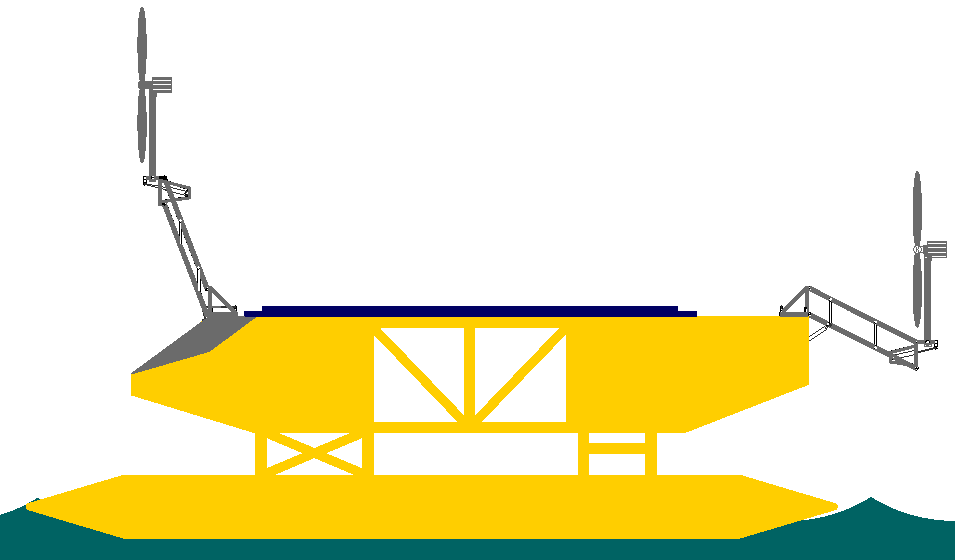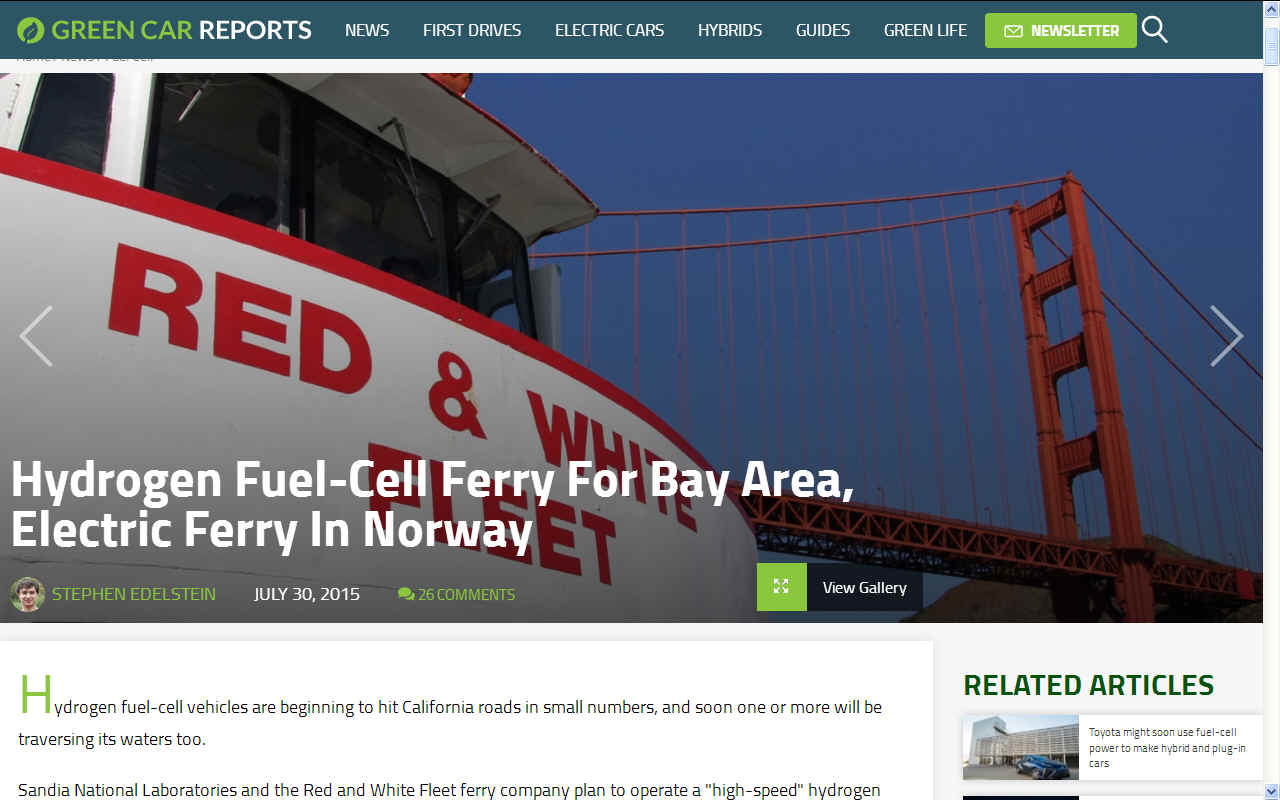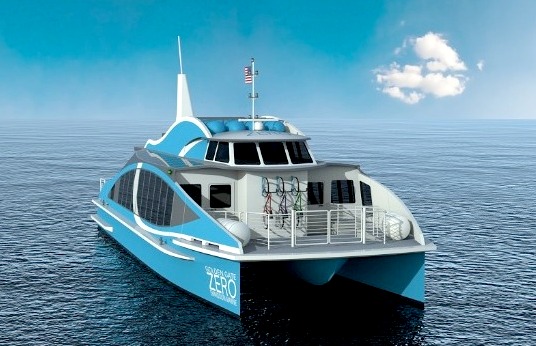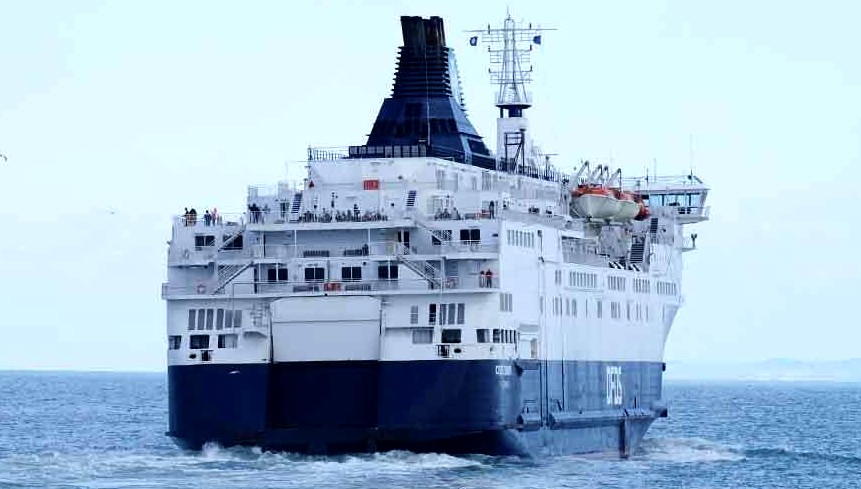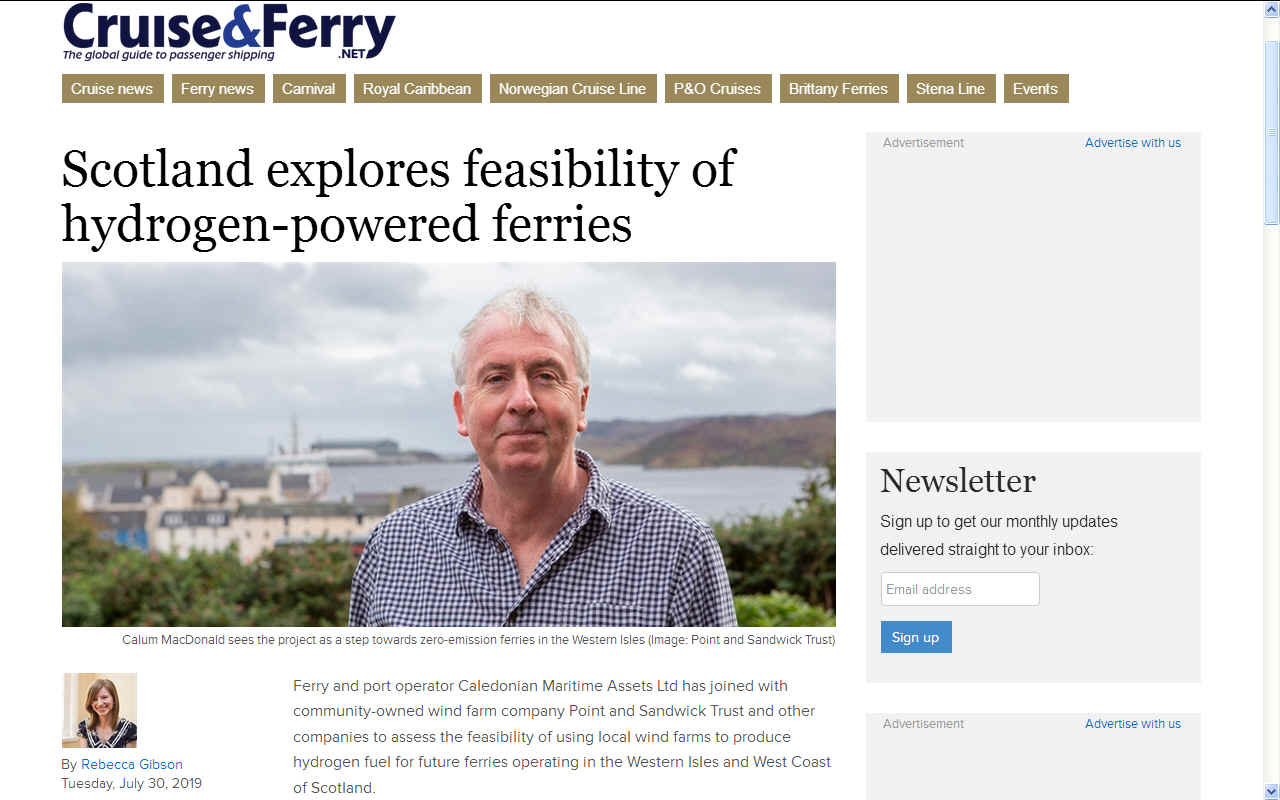|
SF BREEZE - H2 FERRY SAN FRANCISCO
ABOUT - CLIMATE CHANGE - CONTACTS - FERRY OPERATORS - HOME - OCEAN PLASTIC PLEASE USE OUR A-Z INDEX TO NAVIGATE THIS SITE
2018
- The SF BREEZE will consume an estimated 1,000 kilograms (2,204 pounds) of hydrogen per day, and will be supported by a station that can dispense 1,500 kilograms (3,306 pounds) per day.
That will make this station about twice the size of the current largest hydrogen fueling station in the world, officials say. It will also be the first of its kind to support both land and marine use.
In its San Francisco Bay Renewable Energy Electric Vessel with Zero Emissions study, known as SF-BREEZE, researchers at Sandia National Laboratories concluded liquid hydrogen fuel cells are feasible on technical, regulatory and economic bases. Now, researchers are taking the work to the next level in a second study that focuses on the optimal combination of vessel design, speed and passenger capacity, which, once determined, could reduce uncertainty in the industry; and the technical evidence to support new safety codes for hydrogen fuel-cell vessels.
The work is funded by the U.S. Department of Transportation's Maritime Administration's Maritime Environmental and Technical Assistance program.
"The Maritime Administration sees immense potential in the use of hydrogen fuel cells to provide efficient, clean, domestically produced power for the maritime sector. The current effort to improve the economic viability using fuel cells in a commercial vessel will bring this vision one step closer to reality," said John Quinn, Maritime Administration associate administrator for environment and compliance.
Updated regulations could clarify path forward for industry
For example, the LNG code requires LNG vessels to have a clearance of 30 feet around all sides of their vents. Hydrogen is lighter than natural gas and much lighter than air, so it does not sink in air like LNG does. Thus, a 30-foot clearance underneath a vent might not be a necessary requirement for a hydrogen ferry, said Sandia Labs mechanical engineer Myra Blaylock, technical lead for the project.
Labs researchers are using computer simulation to explore and analyze four common vent and leak scenarios in which hydrogen could be released on-board vessels to show actual hydrogen behavior. The computational simulations have underlying physics models that have been validated through experiments and allow researchers to confidently explore various scenarios in a quicker and less-expensive way than conducting experimental work for each individual case. The results can be used by the International Maritime Organization to ensure the accuracy of the codes when applied to hydrogen vessels.
The possibility of extending the applications of hydrogen fuel cells, showing the industry the best path forward and providing the technical basis for new hydrogen regulations, all have "the potential for impact across the entire maritime sector," Pratt said. "A lot of these vessels can travel in ecologically sensitive areas where there is an extra motivation for making them clean. So it's about localized as well as global emissions benefits."
The SF BREEZE is constructed of marine grade aluminium alloy, and is to be powered by two 400 horsepower electric motors. The potentially dangerous hydrogen storage cylinders are located on the roof of the vessel. Trucks will pull up alongside a jetty to pump liquid hydrogen onboard. That means that hydrogen trucks with cryogenic cylinders will be traveling along public roads, so must be extra safe in operation.
JUNE 25 2018 - The California Air Resources Board (CARB) announced a $3 million grant to help build a hydrogen fuel cell ferry to operate in San Francisco Bay. Once built, it would be be the first of its kind in the United States, and the first commercial hydrogen fuel cell ferry in the world. The planned vessel, named Water-Go-Round, would carry 84 passengers and stretch 70 feet long. Construction is expected to start early in the fall in Alameda, California, and the vessel is slated to hit the water in 2019.
The planned vessel, named Water-Go-Round, would carry 84 passengers and stretch 70 feet long. Construction is expected to start early this fall in Alameda,
California, and the vessel is slated to hit the water a year later.
A similar narrative is already playing out with battery-powered ferries, after Norway launched a fully electric car ferry in 2015.
Dan Berentson, the director of public works in Skagit County, in northwest Washington, said his team is closely following developments in Scandinavia, where more electric ferries are expected to ply the fjords. Skagit County officials are now hoping to build their own electric boat to replace their county’s clunky 39-year-old ferry. If all goes to plan, it could launch in 2020.
“Our hope is that the industry will embrace this,” Berentson said.
The group drew up conceptual specifications: a 150-passenger commuter ferry that would travel four 50-mile round-trip routes each day at a top speed of 35 knots (roughly 39 miles per hour) about 60 percent of the time. The ferry could refuel midday, between the morning and afternoon commutes.
- SOLAR & WIND POWERED FERRY - The Cross Channel Challenger (CCC) was a project on the drawing board in 2019 looking for backing to develop a coastal cruiser that is zero carbon just like the hydrogen projects, but where the vessel converts energy from nature onboard for propulsion without risk of hydrogen leaks or fires.
This is a toe-in-the-water project using budget off the shelf equipment to keep the costs down. Hence, the theoretical performance is lower than might be achieved but higher than the current benchmark. It is a useful stepping stone to medium range ferries and eventually bigger ships with longer ranges. Solar combined with wind power could be the winning combination. Comparing the two technologies will be interesting. For sure, the solar powered ferries will be safer and cheaper.
Solar and wind powered vessels do not need big hydrogen tanks next to docks for ships to fill up from. They do not need trucks to deliver the hydrogen from the conversion plants and last but not least, hydrogen is potentially dangerous, as the Zeppelin 'Hindenburg' demonstrated in 1937 when a spark ignited the fated airship, destroying it in minutes.
Since 2019, a study in July 2021 has shown that the hull design in basic, could be adapted to cross the Atlantic on hydrogen power alone, with solar assistance, as a top up power source. Food for thought for Waterborne and Zero Emission Waterborne Transport (ZEWT) advocates in Europe. The aim would be to adapt the concept to practical ZESTA ferries, especially for island nations who depend on shipping for their economies. The proposed design is also safer, leak wise.
Maritime transportation has emerged as one solution to the traffic gridlock that plagues coastal cities. But with urban passenger ferries operating in sensitive environments and tourist areas, hydrogen fuel cell-powered passenger ferries potentially offer a quiet, zero-emission alternative to conventional diesel vessels.
...
CONVERSION, CONVERSION, CONVERSION - It is the number of additional stages of splitting water using electricity, storing as a gas and then recombining it to extract the electricity that was put in at the beginning at a huge net energy loss. Elon Musk has a point don't you think?
Hydrogen is recognised as a fuel with the potential to deliver 100% zero-carbon operation in marine transport, but the systems proposed so far are expensive and complicated, where the first rule of engineering is to Keep It Simple Stupid: KISS.
The allure of the hydrogen economy is plain, splitting ordinary water using electrolysis to obtain oxygen and hydrogen gas is like a schoolboy chemist dream come true, especially if we can generate what appears to be free electricity using solar cells and wind turbines to split the water. Then the hydrogen is free right?
No, not really.
There is a cost, including the cost of manufacturing the solar panels or wind turbines and the transmission line installation and maintenance. The inefficiencies in the conversion and handling chain make hydrogen expensive to produce and so potentially un-competitive - as compared to using the electricity needed to convert water, directly.
In addition, hydrogen is dangerous unless stored very carefully. Space rockets powered by hydrogen and oxygen sometimes explode, with the Hindenburg zeppelin explosion being signs of things to come in a world fraught with human error. We'd be courting disaster. If something can happen, it will happen. Passengers would be traveling in potential time bombs.
CONTACTS
....
A-Z
INDEX OF H2 POWERED FUEL CELL SHIPS
FERRY OPERATORS & ISLAND SERVICES
DFDS -
LINKS & REFERENCE
https://grist.org/article/a-ferry-that-runs-on-hydrogen-fuel-cells-is-coming-to-san-francisco/ https://www.shell.com/energy-and-innovation/natural-gas/lng-for-transport.html http://www.cheetahmarine.co.uk/en/deliveries/worlds-first-hydrogen-powered-boat-smashes-targets https://www.electrive.com/2018/06/20/hyseas-iii-scotland-to-build-first-sea-going-hydrogen-ferry/ https://www.cruiseandferry.net/articles/scotland-explores-feasibility-of-hydrogen-powered-ferries http://www.pointandsandwick.co.uk/news/publication-of-hydrogen-ferry-report/
ADRIATIC SEA - ARCTIC OCEAN - ATLANTIC OCEAN - BALTIC SEA - BAY OF BENGAL - BERING SEA - CARIBBEAN SEA CORAL SEA - EAST CHINA SEA - ENGLISH CHANNEL - GULF OF GUINEA - GULF OF MEXICO - INDIAN OCEAN - IRISH SEA MEDITERRANEAN SEA - NORTH SEA - PACIFIC OCEAN - PERSIAN GULF - SEA OF JAPAN - SOUTH CHINA SEA - SOUTHERN OCEAN
STUDY
PUBLISHED - Point and Sandwick Trust, in collaboration with a number of industry partners (Wood, Siemens-Gamesa, Engie, ITM, CMAL, Johnston Carmichael and Ferguson Marine), have published a feasibility study to assess the suitability of using hydrogen produced from local wind farms to power future ferry services operating in the Western Isles and West Coast of Scotland.
This website is provided on a free basis as a public information service. Copyright © Cleaner Oceans Foundation Ltd (COFL) (Company No: 4674774) 2019. Solar Studios, BN271RF, United Kingdom. COFL is a charity without share capital.
|
